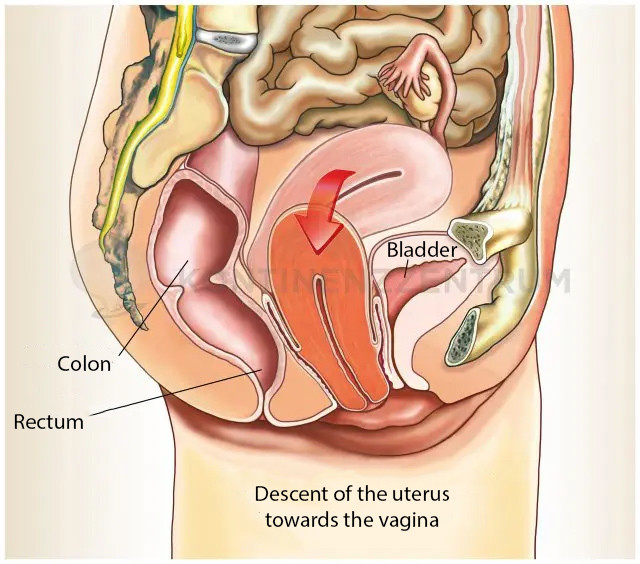Uterine Prolapse: Causes, Symptoms and Treatment Options
A descent of the uterus (descensus uteri) or uterine prolapse into the vagina primarily refers to the lowering of the uterus. A slight weakening of the pelvic floor develops in around half of all women in the course of their lives. The resulting slight lowering of the uterus is often asymptomatic. Preventive measures such as regular pelvic floor training support the muscles and usually prevent further descent. However, if the pelvic floor muscles are more severely weakened, the uterus and cervix may change position until they also protrude into the vagina.
Treatment is not always necessary if the uterus changes position. Patients can discuss their symptoms with their doctor. Depending on the diagnosis, the intensity of the symptoms and the resulting level of suffering as well as the individual circumstances, our experts will decide on the next steps and suitable methods of treatment. The aim is to help the affected patient regain a better quality of life by correcting the uterine prolapse or preventing further prolapse of the organ.
Find Information about Treatment Options for Uterine Prolapse
Contact us for a consultation. We will be happy to provide you with information about your individual assessment and treatment options for uterine prolapse in the pelvis. The Hirslanden Continence Centre in Zurich is open Monday to Friday from 8 a.m. to 5 p.m. You can reach us by telephone on +41 44 387 29 10 or via our online appointment booking system.
Uterine Prolapse: Frequency and Course
Who Can Be Affected by Uterine Prolapse?
Pelvic prolapse is one of the most common conditions in women over the age of 55. In the course of their lives, one in three women in Switzerland suffers from uterine prolapse. In around one in ten women, this pelvic floor prolapse is so severe that surgery is required. Such problems often occur during or after the menopause. However, uterine prolapse can also occur without symptoms. Younger women suffer from this less frequently, e.g. after heavy births.
What Happens when the Uterus and Cervix Descend in the Pelvic Floor?
A prolapse can cause the position of the uterus or the end of the vagina to drop into the vagina (uterine prolapse or vaginal prolapse). This condition can vary in severity and may even result in the uterus or vagina protruding from the vaginal opening. There are four stages of uterine prolapse:
- 1st stage: The uterus (and possibly surrounding organs) descends slightly
- 2nd stage: The organs descend to the vaginal outlet
- 3rd stage: The uterus protrudes up to 1 cm from the vaginal opening
- 4th stage: Complete prolapse of the uterus (total prolapse) - the organ protrudes to a large extent from the vagina
The first stage of uterine prolapse is the most common form. It usually develops over a longer period of time, as the muscles of the pelvic floor lose elasticity and become weaker, especially during the menopause. Preventive, continuous pelvic floor training can prevent this process.
In the case of a second or third stage prolapse of the uterus, the accompanying symptoms such as prolapse of the surrounding organs, problems with bowel and urinary tract emptying and inflammation of the organs can also have a negative impact on the everyday life of those affected.

What is a Stage Three and Four Uterine Prolapse?
Advanced uterine prolapse is when the uterus not only descends but also partially or even completely protrudes from the vagina. If this is not the case, it is sometimes referred to as a descent of the uterus – though “uterine prolapse” is a common term for both mild and advanced uterine prolapse. In the case of a complete prolapse of the uterus, surgery is usually advisable.
What Are the Causes of Uterine Prolapse?
There are many causes of uterine prolapse and the risk can be increased by a wide variety of factors. Weakened pelvic floor muscles can no longer hold the uterus up. This can lead to uterine or vaginal prolapse. The pelvic floor consists of connective tissue and many layers of muscle, which close off the pelvis and hold organs such as the uterus in place. However, the upright gait of humans places great strain on the pelvic floor.
The pressure exerted by the growing fetus during pregnancy, which is concentrated on the pelvic floor during childbirth, puts additional strain on the muscles and ligaments. The muscles are stretchable and – with the help of so-called postnatal exercises – are usually able to recover. This allows the organs to “lift” again. However, repeated or prolonged heavy strain on the muscles in the pelvic floor area can lead to a weakening of the pelvic floor. This increases the risk of uterine prolapse.
Common Causes of Uterine Prolapse Are Therefore:
- Birth of heavy and multiple children (multiples) or a rapid birth order
- Difficult births with the help of a suction cup or forceps
- Long-term heavy physical strain due to work or sport
- Connective tissue can be genetically weakened in advance (pelvic floor weakness)
- Hormone deficiency in the vagina during the menopause
- Chronic cough
- Smoking increases the risk
- Chronic constipation and obesity
- Very rare: Cancer of the pelvic floor
The likelihood of suffering a prolapse increases with age.
Recognizing Symptoms of a Uterine Prolapse
A descent of the uterus (descensus uteri) is not always accompanied by symptoms in mild cases. Therefore, the need for conservative treatment or surgical treatment depends on the symptoms. Furthermore, the degree of descent is not necessarily related to the severity of the symptoms.
Symptoms of Uterine Prolapse Are Usually:
- Pressure and foreign body sensation in the vagina, which is particularly noticeable when standing up
- Lower abdominal and back pain
- Problems during sexual intercourse (pressure or pain)
- Feeling of heaviness and pulling in the pelvic floor
- Difficulty emptying the bladder and bowel in the usual way
- Urinary incontinence when coughing or carrying heavy loads
- Frequent urination
- Cystitis and other urinary tract infections
- Constipation
- Uterus protruding from the vagina (in the case of advanced uterine prolapse)
- Irritation caused by uterine prolapse can lead to ulcers due to the increased pressure, injuries and bloody discharge


What Diagnostic Options Are There for Pelvic Prolapse?
In diagnostics, the clinical examination and a pelvic ultrasound provide precise information about the existing prolapse of the uterus and associated organs such as the cervix. The urodynamic examination can reveal the effects of the prolapse on bladder and pelvic floor function.
First, however, a doctor at the Hirslanden Continence Center will ask you about your medical history and your symptoms such as pain, chronic constipation, etc. and examine your reproductive organs.
If urinary incontinence is present, it is important to differentiate it from other forms that are not caused by the uterus prolapse.
What Treatment Options Are Available?
How we treat uterine prolapse depends on various factors. What (subjective) symptoms occur? Is the pain mild or severe? What is the stage of the uterine prolapse? How old is the patient and what is her general condition? Is there an existing desire to have children?
If pelvic floor weakness is detected during the examination, the doctor will usually first advise targeted pelvic floor exercises. If you are overweight, a healthy diet and additional pelvic floor-friendly exercise such as walking, horse riding or inline skating can also relieve and support the pelvic floor. If the exercises are not enough to strengthen the connective tissue, there are other therapies that can help.
There are generally two types of treatment: conservative and surgical therapy.
Conservative Treatment Options for Prolapse Conditions
As a rule, our specialists initially opt for a conservative approach if the symptoms are comparatively mild (first or second stage of prolapse, minor incontinence).
Conservative therapy involves local hormone treatment and pelvic floor therapy, as well as the pessary procedure. A pessary is a cube, a cup or a ring made of soft silicone, which is available in various sizes. Pessaries can be inserted by the patient herself with the help of a fat or hormone cream in order to alleviate the prolapse and the associated feeling of pressure or foreign bodies.

This type of treatment also includes measures to combat the factors that led to cervical prolapse, such as the treatment of severe obesity or regular smoking, which also represents an increased risk. We can also treat chronic constipation with this procedure.
Conservative therapy also focuses on targeted pelvic floor training and certain techniques for lifting or carrying heavy loads. Consistent pelvic floor training and precisely performed pelvic floor exercises can possibly eliminate the causes of urinary incontinence.
Traditional pelvic floor training can be supplemented by biofeedback and electrical stimulation of the pelvic floor muscles. Biofeedback treatment uses ultrasound or a probe to show the patient the pelvic muscle activity on a screen. Some devices can also emit electrical impulses and train the pelvic floor muscles in this way.
Surgical Procedures for Uterine and Cervical Prolapse
If conservative treatments have not been able to reduce the symptoms sufficiently or if the uterine prolapse is very pronounced, various surgical procedures are used in gynecology.
The aim of the procedures is to reconstruct the original position of the prolapsed organ, thus alleviating prolapse symptoms such as foreign body sensation, pain and incontinence and restoring the normal function of the bowel, rectum and bladder.
In many cases, the operation is performed through the vagina as a shortening of the anterior or posterior vaginal wall. In addition to shortening, it may also be necessary to attach the uterus to the pelvis using a suture on a fixed ligament or to remove the uterus.
In some cases, the doctor may decide to perform the procedure via an abdominal incision. A mesh is attached to the anterior and posterior vaginal wall and fixed to the sacrum. If the organs descend again after the operation, a mesh insertion from the vagina can also be considered.
Modern surgical procedures such as robot-assisted DaVinci surgery can achieve very good results with an advanced stage of prolapse. The Vinci System® is one of the most modern developments in the field of minimally invasive surgery. The doctor is supported by a high-precision surgical robot. The surgeon uses a console to control a robotic unit on the patient's side via a video tower with 3D camera and lighting technology. The use of a robot makes it possible to work much more precisely. The patient suffers less blood loss, requires less pain medication and recovers more quickly overall. Surgical scars are also minimized.
How Can I Prevent Uterine Prolapse?
If you want to prevent a prolapse of the uterus, you can take certain measures. If symptoms are already occurring, these measures can help to prevent the condition from worsening.
- Targeted pelvic floor training, especially during and after pregnancy to enable the best possible recovery
- Weight reduction, if it plays a role as a potential cause
- Endurance sports that do not directly affect the pelvic floor, such as swimming, cycling or running

Find More Information about Individual Treatment Options for Uterine Prolapse
Contact us for a consultation! We will be happy to provide you with information about your individual assessment and treatment options for uterine prolapse. The Hirslanden Continence Centre is open Monday to Friday from 8 a.m. to 5 p.m. You can reach our clinic in Zurich at the following telephone number: +41 44 387 29 10. You are also welcome to use our online appointment booking service.
